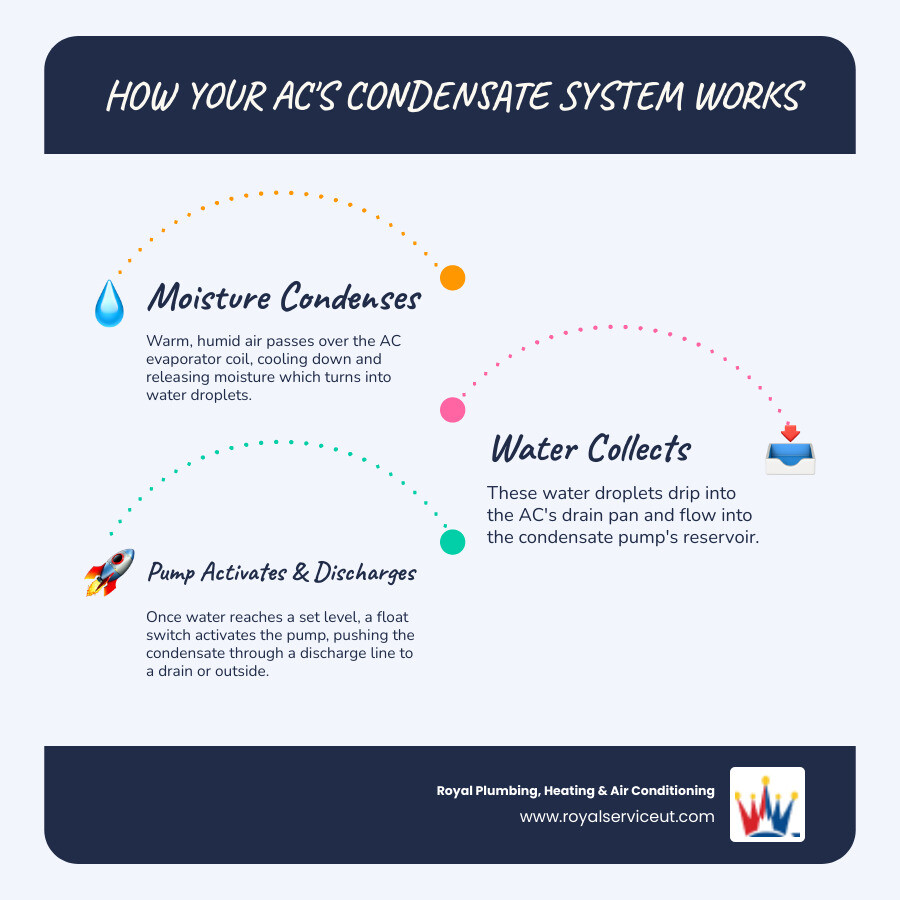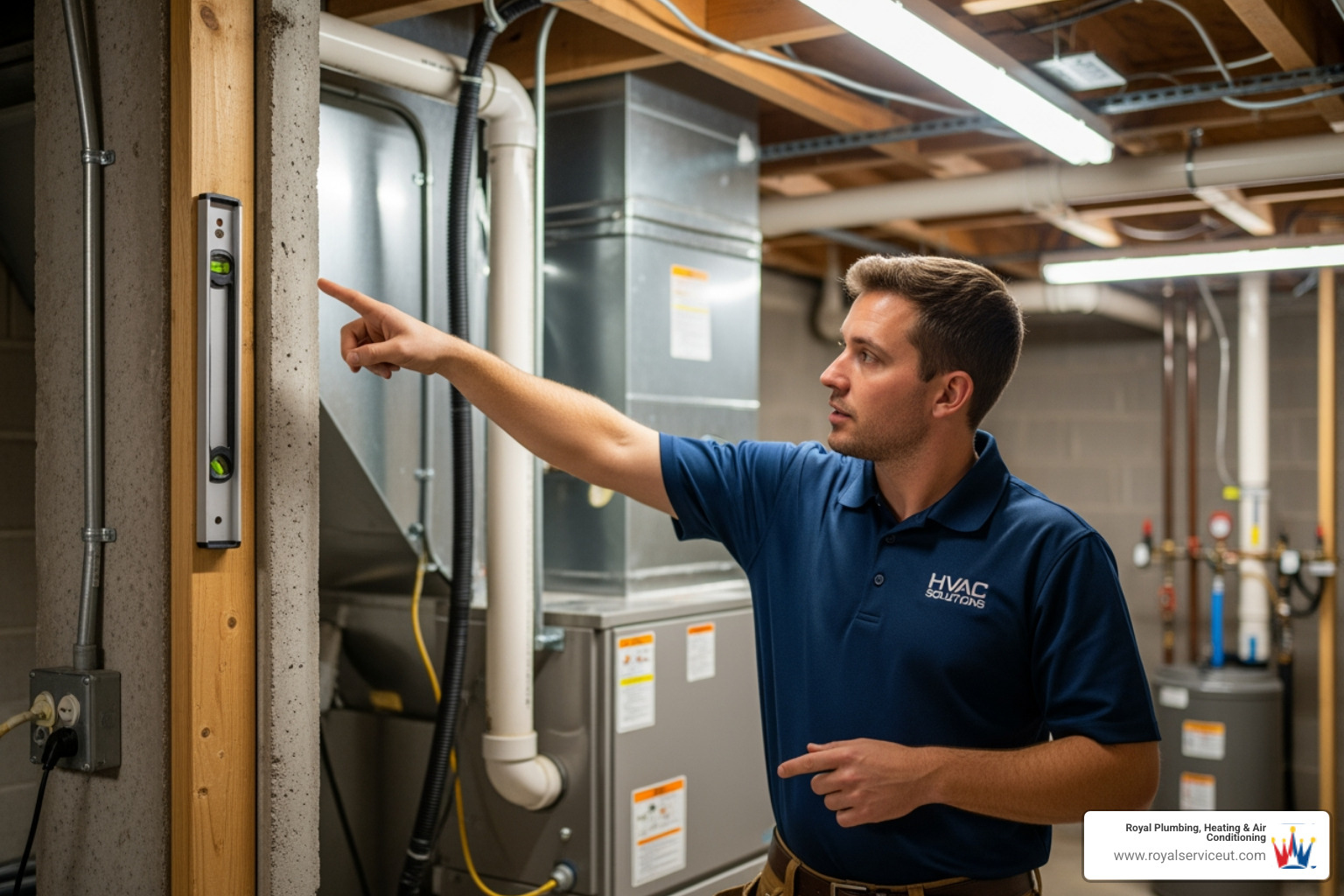Air conditioner drain pump installation involves setting up a small motorized pump to remove condensate water from your AC system. Your AC produces water as it cools, and if the unit is in a basement or can't drain via gravity, a condensate pump is essential. The pump collects water in a reservoir until a float switch activates a motor, which pushes the water through a discharge line to a drain. Without a working pump, your AC's drain pan can overflow, leading to water damage, mold, and system shutdowns.
If you see water pooling around your indoor AC unit or notice a musty smell, a faulty condensate pump could be the culprit. For many Northern Utah homeowners, installing or replacing a pump is a manageable DIY project that prevents costly water damage and keeps your home comfortable.
For comprehensive air conditioning services, visit our AC service page. If you need professional installation help, schedule an AC repair appointment.
I'm Jaryn Ashby with Royal Plumbing, Heating & Air. My early experience in the trades taught me how critical proper condensate management is. A small AC issue can quickly become a major home repair, and a reliable drain pump is your first line of defense.

A condensate pump is a small device that removes the water (condensate) your AC produces during the cooling process. As warm air passes over the cold evaporator coil, moisture condenses and drips into a drain pan. If gravity can't carry this water to a drain—common in basements or older homes—a pump is needed.
The process is simple: water flows from the drain pan into the pump's reservoir. A float switch rises with the water level, and at a set point, it activates a motor. The motor pumps the water through a discharge line to a drain. This cycle prevents the drain pan from overflowing, which is the primary goal of water damage prevention.
A condensate pump is a necessity, not a luxury, in many Northern Utah homes. Here’s why:
The main benefits are preventing overflow and protecting your home. An overflowing drain pan can damage floors, walls, and HVAC electrical components. The resulting stagnant water also creates a breeding ground for mold and mildew, which harms indoor air quality. Furthermore, a clogged or overflowing pan can trigger your AC's safety switch, shutting the system down on the hottest days.
A modern condensate pump's most important feature is its safety switch. This is your backup plan if the pump fails due to a clog or motor issue. If water in the reservoir rises too high, a secondary float activates the safety switch.
This switch is typically wired into your AC's low-voltage thermostat circuit. When activated, it breaks the circuit and shuts off the AC unit, stopping condensate production and preventing a flood. Some switches may also trigger an alarm. This simple mechanism is crucial for preventing catastrophic water damage, especially when you're away from home. The wiring usually involves connecting two low-voltage wires in series with the thermostat's power wire (often the red 'R' wire), interrupting the signal for cooling if the water level becomes critical.
Proper preparation is key to a smooth air conditioner drain pump installation. Before you begin, take these essential steps.

First and foremost, turn off the power to your HVAC system at the breaker box. Working with electricity and water is dangerous, so this step is non-negotiable. If you're replacing an old pump, check its label and match the horsepower and voltage for the new one. Most residential pumps are 115V. Also, it's wise to check your local codes in Northern Utah, as some municipalities have specific rules for condensate discharge.
Gather your tools and materials before you start to avoid interruptions. You will need:
Where you place the pump is critical for proper function. Follow these guidelines:
With your tools gathered and the location chosen, you can begin the air conditioner drain pump installation. Work carefully and follow these steps.

First, remove the old pump. Confirm the power is OFF at the breaker. Use a bucket or wet/dry vac to drain residual water from the old pump and AC drain pan. Next, disconnect the inlet and discharge tubing. Before disconnecting any wires, take a photo of the existing wiring—this will be your guide for the new installation. Then, disconnect the power and safety switch wires and remove the old pump.
Now, position the new pump. Place it in your chosen spot, ensuring it's below the AC drain pan. Use your level to confirm the pump is perfectly horizontal so the float switch can operate correctly. Make sure any vent slots on the pump are unobstructed. Finally, secure the pump to the wall using the provided mounting tabs. Use wall anchors if drilling into drywall to prevent vibration from loosening it over time.
This step ensures water flows correctly into and out of the pump.

This is the most intimidating step, but your reference photo will make it manageable. Double-check that the power is off.
If you are at all uncertain about the electrical work, it's always best to call a professional. The technicians at Royal Plumbing, Heating & Air Conditioning can ensure your pump is wired safely and correctly.
After completing the physical air conditioner drain pump installation, you must test your work to ensure everything functions correctly.
Don't skip this final check. First, restore power to your HVAC system at the breaker. Then, perform a manual test:
If the pump runs continuously or doesn't shut off, the float switch may be stuck. Make sure it can move freely.
Even with a careful installation, issues can arise. Here are quick fixes for common problems:
A well-maintained pump can last for decades. Follow these simple tips:
Homeowners in Northern Utah often have questions about condensate pumps. Here are answers to the most common ones regarding air conditioner drain pump installation and care.
The lifespan of a condensate pump varies widely, from 1 to 15 years. However, with regular maintenance, many pumps can last 20 to 30 years. The key factors are usage frequency, water quality, and—most importantly—consistent cleaning. A pump that is cleaned monthly and treated with algae prevention tablets will have a much longer service life.
Your pump will usually give you warning signs before it quits. Look out for:
Any of these signs mean it's time to investigate before a small issue becomes a flood.
Yes, absolutely. Local plumbing and electrical codes exist to ensure safety. These regulations cover:
Codes can vary by municipality. Always check with your local building department before starting. For guaranteed compliance, the professionals at Royal Plumbing, Heating & Air can ensure your installation meets all local standards.
By installing your own condensate pump, you've completed a valuable project that protects your home from water damage and keeps your AC running efficiently. This hands-on experience provides the satisfaction of a job well-done and a better understanding of your home's HVAC system.
However, not every project is right for a DIY approach. If you run into complex wiring or face persistent clogs, there's no shame in calling a professional. The peace of mind that comes with an expert installation is invaluable, especially when protecting your home from water damage.
At Royal Plumbing, Heating & Air, we help Northern Utah homeowners from Logan to Salt Lake County with these exact challenges. Our experienced team provides reliable solutions custom to your home's needs. Whether you need help with a tricky installation or want to maintain your entire HVAC system, we are committed to ensuring your royal comfort.
When you need us, we're here. For professional assistance with your condensate pump or any other AC concerns, get professional AC installation help from our team. Your home deserves to be safe, dry, and comfortable.
Find answers to frequently asked questions about our services.
By reading this blog post, you will gain valuable insights and knowledge that can help you in your daily life.
The purpose of this blog post is to inform and educate readers about a specific topic, providing them with useful information and tips.
The target audience for this blog post includes individuals who are interested in learning more about the topic and seeking practical advice.
You can apply the knowledge and tips shared in this blog post to your own life by implementing them in your daily routine.
The benefits of reading this blog post include gaining new perspectives, acquiring practical skills, and enhancing your overall knowledge on the topic.
Absolutely! Feel free to share this blog post with your friends, family, or anyone who might find it helpful or interesting.
Yes, the information provided in this blog post is reliable and based on credible sources. We strive to ensure the accuracy and quality of the content we share.
The benefits of reading this blog post include gaining new perspectives, acquiring practical skills, and enhancing your overall knowledge on the topic.
If you have more questions related to the blog post topic, please don't hesitate to contact our team. We're here to help!
We value your feedback! If you have any suggestions, comments, or feedback regarding this blog post, please let us know. Your input is important to us.
Trust our team of dedicated professionals for all your HVAC and plumbing needs.